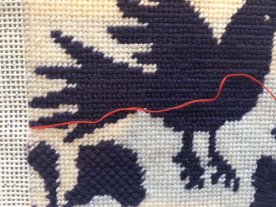How to Stitch Outlines in Needlepoint

Some needlepoint canvases have thin outlines around features, and stitchers often ask if they're supposed to stitch these lines.
This Brontosaurus canvas has the type of outlines we're talking about...
 |
| Green Brontosaurus by Alice Peterson with a fine black outline around the dinosaur and other features. |
There are a few ways to approach this:
Don't stitch the outlines.
In some cases ignoring the outline is okay. On this tile design you could easily ignore the outlines.But, on the dinosaur canvas the outline separates anatomical features . The artist could have used shading or color changes to do this but since an outline was used it needs to be stitched in. But, the outline is very fine, so if you were to use option number 2...
Use a tent stitch to stitch the outline.
This will give you a thick line, which might work well on a large canvas, but on a small piece like the dinosaur design, a black line of one tent stitch in width will overwhelm the piece. Also, doing it this way won't give you a smooth line, as tent stitches don't curve well.
 |
 |
| An outline using a tent stitch gives a thicker line and one that doesn't curve well - it looks like steps. | A thicker line works well on a larger canvas like the green outlines on the white flowers on this Aqua Flower Burst pillow canvas. |
Use surface embroidery.
This is one of our favorite ways to stitch outlines - it's quick and easy.To outline the dinosaur and other features in the design above, you might use a single strand of cotton i.e. 1 or possibly 2 strands of 6-stranded cotton floss, and stitch the outline on at the end as surface embroidery using a Back Stitch, or a Wrapped Back Stitch (great for smoothing out curves). In order to do this, you should take a photograph of the canvas before you stitch it so you can see where these fine outlines are - because you'll be stitching over them before you stitch them on at the end!
 Image supplied by Cara
Image supplied by Cara
For more detail and instructions about needlepoint couching click here.
 |
| This Home Is Where The Heart Is design by Jennifer Pudney has the outlines stitched on at the end as Back Stitch surface embroidery. |
Use A Split Stitch.
With a Split Stitch the needle splits the thread of the previous stitch as it begins the next stitch. Following the diagram below, come up with one canvas thread between 2 and 3. You can vary the number of canvas threads that you go back - fewer for curves or more for straight lines. For floss, try to split an even number of strands on either side. A Split Stitch is a good way of achieving a thin and smooth curve. Thanks to Cara for this idea! Image supplied by Cara
Image supplied by CaraCouch the Outline.
Because it's a thin line we're trying to achieve, if you want to use a couching technique you would lay down two strands of embroidery floss, and then couch or tie it down with a single strand. The nice thing about couching is you can direct the line wherever it needs to go, and it sits on top of the stitches that are already there. Thanks to Linda for this gem of an idea! |
 |
 |
For more detail and instructions about needlepoint couching click here.
If you enjoyed this article please Pin Me or share me on your favorite social media channel...
Oh, and sign up for our newsletter at the bottom of the page - so you don't, you know, MISS OUT ... 


